Bernanke’s announcement of Operation Twist last week sent the US dollar into risk-on mode, piling up big gains against other non-safe haven currencies as we will see below. When the big investors are worried about risk or want to avoid volatility in the stock and commodities markets, they fly to cash and short term treasuries to preserve capital. Last week was no different for Operation Twist.
Now, however, that temporary boost to the dollar is beginning to unwind as we are back in risk-off mode and the institutional investors slowly move their money back into various trade positions in stocks, commodities, and long term debt.
Here we have the Eurodollar trade on an daily chart. We can see upon the Fed announcement that the pair faded quite strongly on the 21st and 22nd. But if you notice, the Eurodollar has been slowly recovering since then as traders unwind their fear positions. With 85 pips or so left to go to fully retrace to pre-twist levels, going long Eurodollar may be a good short term recovery trade for scalpers.
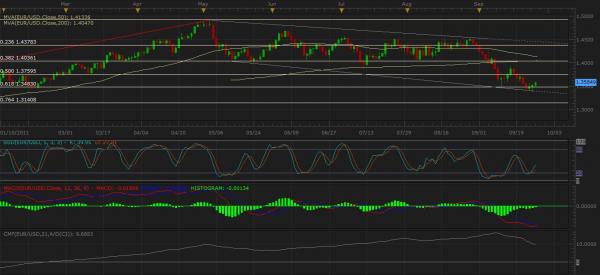
Next up, the Pound Dollar on a daily chart. Here we can see the the strong move through the .764 Fibonacci (from July 2010 low to April 2011 high) line not quite matching a YoY low in the pair. Since, the GBP has retraced 320 pips and looks to challenge pre-announcement position as well.
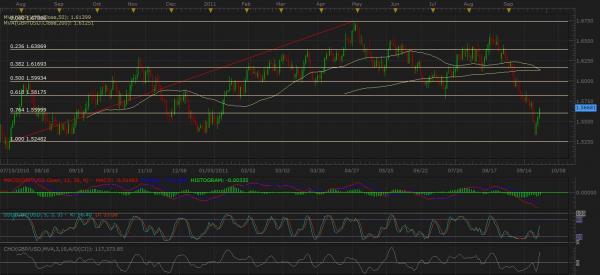
Next up, we look at the USD Cad. The pair started 9-19 in an upswing from the 200 day moving average, and operation twist fear trade propelled the pair an additional 400 pips to the upside. finding resistance at the .764 Fibonacci line (August 2010 high to July 2011 low). We see retracement touching the .618 Fib level. Watch this one closely, if it passes below and sticks below the 1.019 level for two days, the pair may be ready to run a bit to the downside. Volume will be key to watch here.
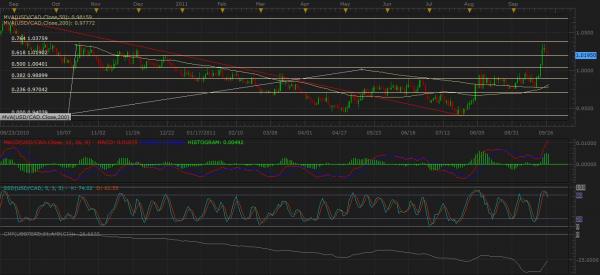
Next, the Aussie USD pair move strongly to the downside on the Fed news, signaling strength of the underlying US dollar on the trade. The pair had begun fading on the 19th to the .382 Fibonacci (based on the pair low in August 2010) and the Fed news pounded the Aussie much further, moving two Fib lines down to .618 acting as support. I think this was oversold to the US Dollar’s favor, and I expect a march back up to 1:1 territory. As we speak, the pair is trading up and testing the 0.5 Fib on the yearly range already. I expect more strength in the Aussie simply because the country’s economic fundamentals are better than the US. But watch for risk-on events that will sharply drop this pair as traders seek the safe haven of the dollar.
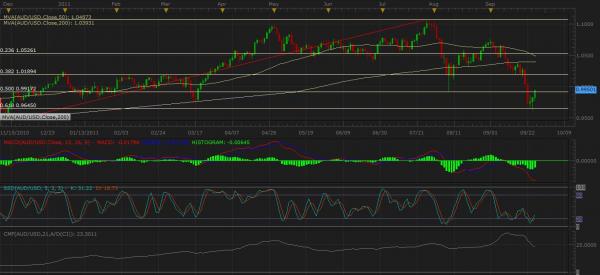
Next, we’ll look at the USD against another safe haven currency, the Japanese Yen. Notice, interestingly, how the Yen fared in the fear trade, besting the US Dollar. The market didn’t move away from the Yen and into the dollar, and continued the fade in the pair to the Yen’s advantage. The pair is testing the 0.00 Fib dating back to July’s high of last year and the low in August 2011. It has bounced a couple of times off this level and appears to have settled in a range. While Japan has it’s own issues, it appears as though traders feel the near term risk in the US Dollar is a bit higher, or that the US Dollar was a bit overvalued compared to the Yen. I don’t look for a strong move in this pair sans a big bout of news, but the pair is interesting to determining how the big money views the two safe haven currencies.
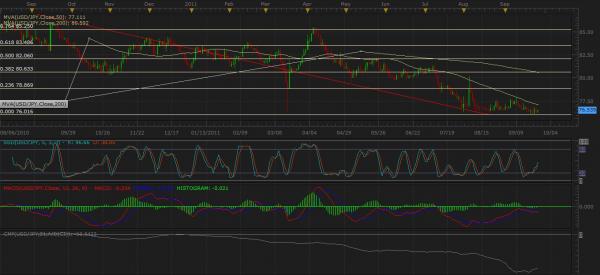
One other interesting trade that I wanted to note is the US Dollar against the Singapore dollar. The pair vaulted 483 pips last week on the Fed announcement. Because Singapore, like the Aussie, has much stronger economic fundamental support than the US Dollar, the pair has sharply trade back about halfway to pre-announcement levels. This could be, sans another risk-on event in the markets, a very good short trade back to the 1.263 level. Even though the pair was trading up overall in September, the announcement of Operation Twist highlights the continuing fiscal issues in the US and should serve as a catalyst to slowing the pair’s rise up. Singapore is just a better currency, period, even if it is not currently considered a safe haven.
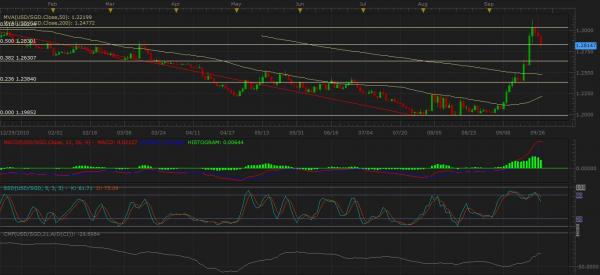
Overall, it appears as though money is flowing back into risk-off trades in the stock market and currency markets. You can see how big traders flock to the US Dollar in times of uncertainty, especially around big Fed announcements. Regardless of the fact Operation Twist was not QE3, you can see general fear sentiment in the institutional money which leads to relative overreactions in the currency markets. When you are trading forex, be very careful to exit long positions when these types of news events occurs. You can get stopped out of your trade very quickly as safe haven currencies, such as the dollar, get the teacher’s pet treatment for a few days.
However, once the market has time to digest the impact of the actual news event, trades tend to move back in the same direction they were already going. The few days and weeks after a big news announcement is often the best place to enter a trade, taking pips to the expected swing and then counterswing trends. Knowing how safe haven currencies react to such news events, and the volatility they bring, can be the currency trader’s best friend when carefully traded with proper stops in place.



